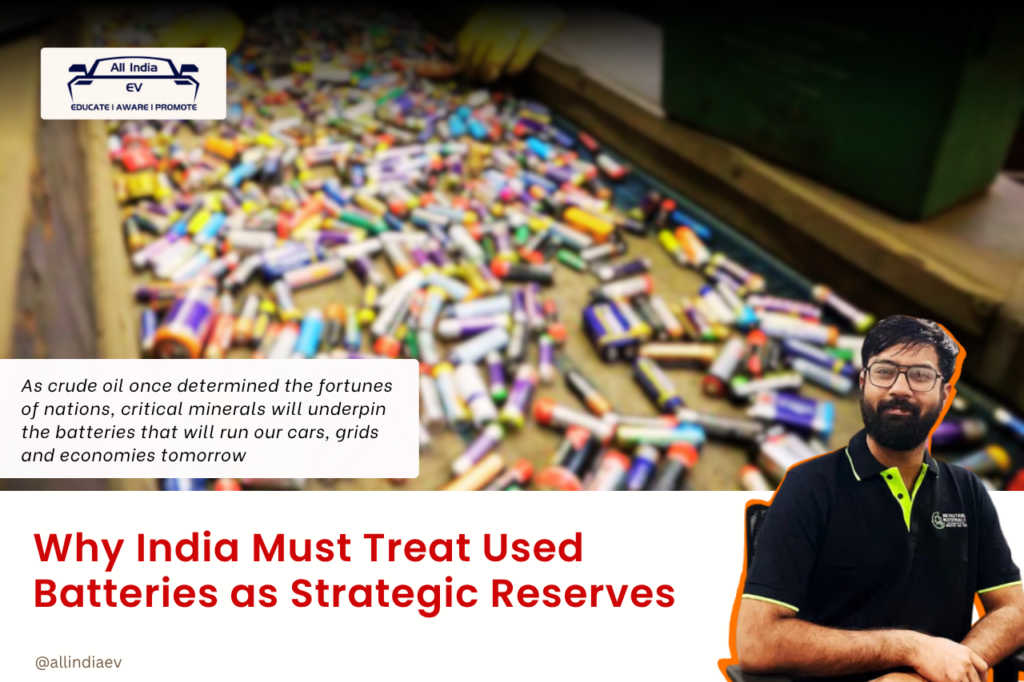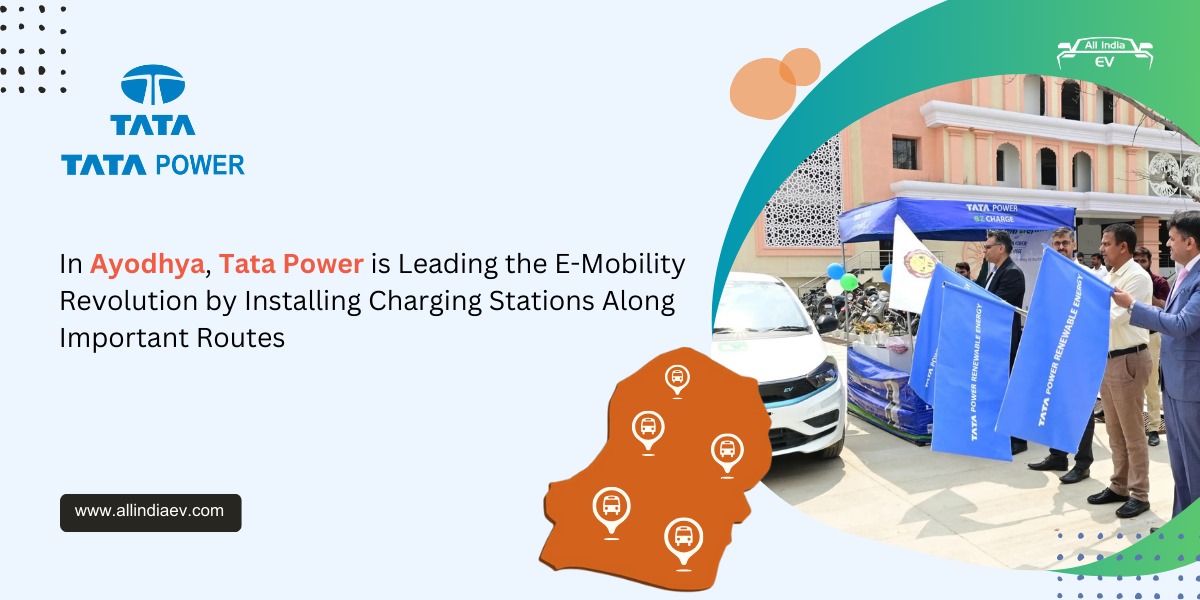
Critical Minerals to Power the Future: How Batteries Will Drive Cars, Grids, and Economies Like Oil Once Did
- The new oil of the 21st century
- A growing mineral well within our borders
- Learning from the oil era
- Global race for mineral dominance
- Building the refining power of the new era
- Building a formal battery reserve mechanism
- From necessity to foresight
- The road to a battery-secure future
- Conclusion: Batteries as the new reserves of national power
As India accelerates its transition toward clean energy and electric mobility, a new form of wealth is emerging quietly in our hands — waste batteries. Every Indian today carries a fragment of the nation’s mineral future — in the smartphones, laptops, EVs, and energy storage systems that power daily life. These devices hold the key to India’s energy independence — the battery, a modern equivalent of oil for the 21st century.
Batteries sit at the heart of the global energy transition, storing renewable power and powering everything from vehicles to industrial systems. As India scales its solar, EV, and data infrastructure, battery demand will become a critical determinant of national competitiveness, just as crude oil once defined global power structures.
The new oil of the 21st century
Every battery contains copper, lithium, nickel, and cobalt — minerals that are classified as critical for energy storage and industrial growth. The global scramble for these resources has intensified, echoing the oil rush of the 20th century. Critical minerals are the new crude oil — the essential fuel for electric vehicles, renewable energy grids, and the digital economy.
While India once struggled with oil shocks, it now has the opportunity to pre-empt future “mineral shocks” by treating waste batteries as strategic reserves instead of discarding them. If oil was the fuel of the last century, used batteries are the reserves of this one.
A growing mineral well within our borders
By 2030, India is expected to add over 80 GWh of new battery capacity annually for electric mobility and renewable storage. Typically, these batteries complete their first life cycle within six to eight years, after which they can yield a secondary flow of copper, nickel, lithium, and cobalt.
In 2022, India generated over 50,000 tonnes of lithium battery waste, and this figure is projected to increase tenfold by the decade’s end. This massive stream of battery waste represents a continuously replenishing mineral resource, one that could significantly reduce dependence on imports if harnessed strategically.
Learning from the oil era
During the 1990s, India responded to oil shocks by building strategic petroleum reserves and expanding its refining infrastructure. That same foresight must now guide the nation’s battery and critical mineral strategy.
The Battery Waste Management Rules (2022) already mark an important policy milestone, emphasizing producer responsibility, traceability, and recycling mandates. However, experts suggest taking this a step further — through national inventorying of used batteries, creating battery banks, and aligning this effort with the National Critical Mineral Mission (2025) of the Ministry of Mines.
Global race for mineral dominance
The geopolitics of energy is shifting from oil wells to battery minerals. Today, China processes over 70% of global lithium and nearly 80% of cathode materials, making it the OPEC of critical minerals. In response, the EU, Japan, and the US are investing heavily in mineral stockpiles and supply chain alliances to secure their futures.
For India, which aspires to lead the global clean energy movement, reliance on imports exposes it to price volatility and export restrictions. In FY2024, India imported critical minerals worth $3 billion, primarily from a few nations — a concentration that heightens supply chain vulnerability.
By developing domestic recycling and refining capabilities, India can hedge against future resource shocks and strengthen its strategic autonomy.
Building the refining power of the new era
India’s transformation from a crude importer to a refining powerhouse— particularly after the Gulf War energy crises — offers a blueprint for battery materials. A similar leap can be achieved by investing in metal recovery, processing technologies, and regional recycling hubs that supply domestic gigafactories and export markets.
With policy incentives, technology partnerships, and assured demand, recycling plants could evolve into the green economy’s equivalent of Jamnagar refineries — turning waste into wealth and import dependence into trade advantage.
The recently announced ₹1,500 crore government scheme for recycling and reprocessing of battery materials is a crucial step in this direction. Such initiatives could help anchor the nation’s circular economy, providing both environmental and economic returns.
Building a formal battery reserve mechanism
To truly institutionalize battery recycling as a strategic resource, India needs a formal battery reserve mechanism — akin to its oil stockpile system.
This would involve the inventorying of end-of-life batteries, with OEMs depositing data into a national mineral database, ensuring that batteries are channelized to authorized recyclers. Such reserves would:
- Stabilize supply for India’s growing network of gigafactories.
- Provide price visibility for critical minerals.
- Ensure recovered metals remain within India’s manufacturing ecosystem.
This approach would not only secure material availability but also generate new jobs, encourage private investment, and create a sustainable loop of resource recovery — a cornerstone of the circular economy.
From necessity to foresight
India’s oil reserve strategy was born out of necessity — a reaction to external crises. Its battery reserve strategy, however, must stem from strategic foresight.
The materials that will power India’s clean energy future already exist within its borders — embedded in discarded electronics, retired EVs, and expired energy storage units. If India can recycle and refine these materials domestically, it can transform vulnerability into leadership.
The transition to a battery-secure economy will not only enhance energy sovereignty but also reduce emissions, save foreign exchange, and position India as a global leader in sustainable mineral management.
The road to a battery-secure future
To realize this vision, India must act on several fronts:
- Establishing large-scale recycling and refining hubs across major industrial corridors.
- Integrating digital tracking systems for end-of-life batteries through extended producer responsibility (EPR) mechanisms.
- Creating public-private partnerships for research, innovation, and capacity building in battery recovery technologies.
- Aligning mineral recovery goals with the National Mission on Transformative Mobility and Battery Storage.
Each recycled battery is a step closer to energy independence. Every recovered gram of lithium, nickel, or cobalt adds resilience to India’s green manufacturing ecosystem.
Conclusion: Batteries as the new reserves of national power
In an era defined by clean energy, batteries are the new oil, and waste batteries are untapped reserves. They represent not just latent wealth, but a strategic opportunity for India to redefine its place in the global energy order.
If the country can treat its spent cells with the same seriousness as crude, build domestic recycling and refining capacities, and govern them with a national reserve vision, it can transform waste into strategic wealth.
By mastering the art of battery recovery, India can command not just a greener future, but also greater sovereignty — emerging as a mineral power in the new energy age.
Batteries are the lifeblood of the clean economy. Treating them as reserves is the key to India’s energy independence and industrial leadership.
Author– Shubham Vishvakarma
Co-Founder and Chief of Process Engineering,
Metastable Materials










